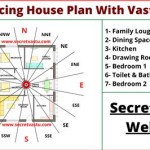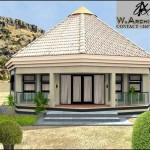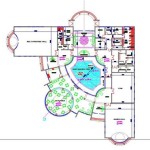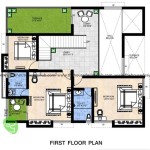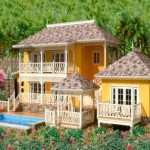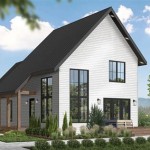Wrap Around House Plans: Design, Benefits, and Considerations
Wrap around house plans, characterized by a porch or veranda that extends around much or all of the home's perimeter, offer a distinctive architectural style with a range of functional and aesthetic benefits. These designs evoke a sense of traditional charm while providing ample outdoor living space. Understanding the key elements of wrap around house plans, their advantages, and the considerations involved in their implementation is essential for homeowners and builders alike.
Defining Characteristics of Wrap Around House Plans
The defining element of a wrap around house plan is the continuous porch or veranda. Typically, this feature extends along at least two sides of the house, often encompassing three or even all four. The porch is usually covered, providing shelter from the elements and creating a transition zone between the interior and exterior environments. This covered space offers opportunities for relaxation, entertaining, and enjoying the surrounding landscape.
Architectural styles incorporating wrap around porches are diverse. Common examples include farmhouse, Victorian, Craftsman, and even modern designs. The style is often adapted to the specific climate and regional vernacular. For instance, in warmer climates, wrap around porches can maximize shade and ventilation, while in cooler regions, they can provide a sheltered space to enjoy the outdoors.
Materials used in the construction of wrap around porches vary depending on the style and budget. Wood is a prevalent choice, offering a classic and warm aesthetic. Composite decking materials provide durability and low maintenance. Railings can be constructed from wood, metal, or a combination of both, complementing the overall architectural design.
Advantages of Wrap Around House Designs
Wrap around house plans offer numerous advantages, contributing to enhanced living experiences and increased property value. These benefits range from improved outdoor living to enhanced energy efficiency.
One significant advantage is the increased outdoor living space. The wrap around porch provides a generous area for relaxing, dining, and entertaining. It allows homeowners to enjoy the outdoors regardless of weather conditions, offering a shaded retreat during hot summer months and a protected space during light rain. This extension of the living space enhances the functionality and enjoyment of the home.
Another benefit is the enhanced curb appeal. The wrap around porch adds a distinctive architectural feature that increases the visual appeal of the house. It creates a welcoming and inviting atmosphere, enhancing the property's overall aesthetic and potentially increasing its market value. The porch can be further enhanced with landscaping, furniture, and decorative elements, personalizing the home's exterior.
Energy efficiency can also be improved through wrap around porch design. The porch roof provides shade to the house's walls, reducing direct sunlight exposure and minimizing heat gain during the summer. This passive cooling effect can lower air conditioning costs and contribute to a more comfortable indoor environment. In colder climates, the porch can act as a buffer, providing insulation and reducing heat loss.
Privacy is another advantage offered by wrap around porches. They create a visual barrier between the interior of the house and the outside world, offering increased privacy for residents. The porch can also provide a vantage point for observing the surrounding property and neighborhood, enhancing security.
Key Considerations in Wrap Around House Planning
Planning a wrap around house requires careful consideration of several factors, including site conditions, budget, and design preferences. Adequate planning ensures that the final product meets the homeowner's needs and expectations.
Site conditions play a critical role in the design and construction of a wrap around porch. The orientation of the house on the lot significantly impacts the amount of sunlight the porch receives. Ideally, the porch should be oriented to maximize shade during the hottest part of the day and capture gentle breezes. The topography of the site also influences the design, as the porch may need to be elevated or terraced to accommodate sloping terrain.
Budget is another essential consideration. The cost of constructing a wrap around porch can be significant, depending on the size, materials, and complexity of the design. Homeowners should establish a realistic budget and prioritize features that are most important to them. Comparing quotes from multiple contractors and selecting cost-effective materials can help control expenses.
Design preferences also influence the planning process. The architectural style of the porch should complement the style of the house and reflect the homeowner's personal taste. Design elements such as railings, columns, and flooring should be carefully selected to create a cohesive and aesthetically pleasing look. The porch should also be designed to accommodate the intended use, whether it's for relaxing, dining, or entertaining.
Accessibility is a crucial factor to consider during the design phase. The porch should be accessible to all members of the household, including those with mobility limitations. Ramps or gently sloping walkways can provide access for individuals using wheelchairs or other mobility aids. The porch should also be well-lit to ensure safety at night.
Building codes and regulations must be adhered to when planning a wrap around porch. Local building codes may specify requirements for porch size, railing height, and structural integrity. Homeowners should consult with a licensed architect or builder to ensure that their design complies with all applicable regulations.
Maintenance requirements should also be considered. Wrap around porches can be exposed to the elements, requiring regular maintenance to prevent deterioration. Wood porches need to be painted or stained periodically to protect them from moisture and insect damage. Composite decking materials offer lower maintenance requirements but may still require periodic cleaning. Homeowners should select materials that are durable and easy to maintain.
The size of the porch should be proportionate to the size of the house. A porch that is too small may feel cramped and uncomfortable, while a porch that is too large may overwhelm the house's aesthetic. The ideal size depends on the intended use and the overall design of the house.
Integrating the porch seamlessly with the interior of the house is essential for creating a cohesive living space. Doors and windows should be strategically located to provide easy access to the porch from the interior. Large windows or sliding glass doors can create a sense of openness and connection between the indoor and outdoor spaces.
Landscaping around the porch can enhance its aesthetic appeal and create a more inviting outdoor environment. Plants, flowers, and trees can provide shade, privacy, and visual interest. Consider using native plants that are adapted to the local climate and require minimal maintenance. Paths and walkways can lead to the porch from other areas of the yard, creating a cohesive landscape design.
Lighting is an important element to consider when planning a wrap around porch. Adequate lighting is necessary for safety and security, as well as for creating a welcoming atmosphere. Consider using a combination of ambient, task, and accent lighting to create a layered lighting scheme. Ambient lighting provides overall illumination, task lighting focuses on specific areas, and accent lighting highlights architectural features or landscaping elements. Low-voltage lighting can be used to save energy and create a soft, warm glow.
Furniture selection is critical for creating a comfortable and functional outdoor living space. Choose furniture that is durable, weather-resistant, and appropriate for the intended use. Consider using a mix of seating options, such as chairs, sofas, and benches, to accommodate different groups and activities. Outdoor rugs, pillows, and throws can add comfort and style to the porch.
Finally, consider the impact of the porch on the surrounding environment. Design the porch to minimize environmental impact by using sustainable materials, reducing water usage, and preserving natural resources. Consider using recycled or reclaimed materials for the porch construction. Install rainwater harvesting systems to collect rainwater for irrigation. Preserve existing trees and vegetation on the site to provide shade and habitat for wildlife.

Wrap Around Porch House Plans For A 4 Bedroom Country Home

3 Bedroom Open Floor Plan With Wraparound Porch And Basement

Country Style House Plan With Wrap Around Porch

Complete Wrap Around Porch 58304sv Architectural Designs House Plans

Ardmore Park Country Home House Plans Farmhouse Floor Style

Modern Farmhouse Plan With Wraparound Porch 70608mk Architectural Designs House Plans

Country Style House Plan With Wrap Around Porch Farmhouse Plans

Popular Modern Farmhouse Plan With Wraparound Porch
Southern Living Dreamy House Plans With Front Porches Blog Dreamhomesource Com

Wrap Around Porch House Plans

